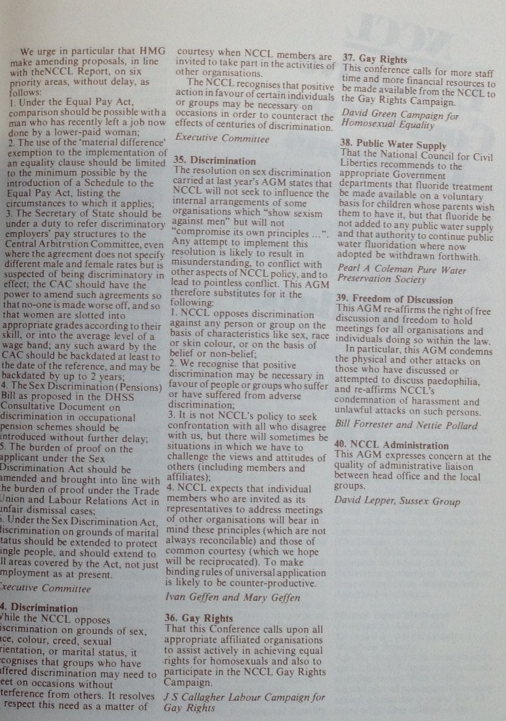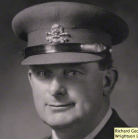In 1978, during the passage of the Protection of Children bill through Parliament, and just as PIE were preparing to publish their Paedophilia: Some Questions & Answers and distribute the booklet to MPs pigeonholes in the House of Commons, Tom O’Carroll, Chairman of Paedophile Information Exchange and member of the NCCL Gay Rights Committee wrote to Antony Grey in his role on the Executive Committee of the Defence of Literature and Arts Society (‘DLAS’).
O’Carroll wanted to thank Grey for his support at the 1978 NCCL Annual General Meeting and “in  relation to” the National Union for Public Employees. The NCCL AGM had taken place on 1-2 April at City University, a fortnight prior to O’Carroll’s letter.
relation to” the National Union for Public Employees. The NCCL AGM had taken place on 1-2 April at City University, a fortnight prior to O’Carroll’s letter.
“Dear Antony, I was pleased to see you the other day, and only regret that I had to dash off without having a chance to talk to you after the meeting. Allow me, however, to thank you very much for your support at the NCCL AGM, and in relation to NUPE etc.”
At the 1978 AGM which O’Carroll and Grey had attended, PIE member Nettie Pollard had seconded a motion proposed by Bill Forrester to ask NCCL to condemn the protests against PIE’s meeting in September 1977:
“This AGM re-affirms the right of free discussion and freedom to hold meetings for all organisations and individuals doing so within the law.
In particular this AGM condemns the physical and other attacks on those who have discussed or attempted to discuss paedophilia and re-affirms NCCL’s condemnation of harassment and unlawful attacks on such persons.” [Bill Forrester and Nettie Pollard]
Tom O’Carroll was responding to an approach made by DLAS to David Grove, PIE’s Children Rights’ Campaign leader and keeper of the PIE mailing list.
In June/July 1976 edition of Understanding Paedophilia (PIE’s forerunner to Magpie) the ‘Magnificent Six’ had been announced, with the following people undertaking the following roles for PIE
‘It’s the Magnificent Six’, p. 7
New EC:
Keith Hose – re-elected to serve as National Chairperson for the coming year
Warren Middleton – re-elected as National Vice Chairperson/PIE Magazine Editor
Tom O’Carroll – elected as PIE General Secretary/responsible for the formation of local groups/PIE members’ contact service/Publicity [See further: Did NCCL’s trawl of List 99 radicalise PIE’s Tom O’Carroll? Palaver #6 October 1976]
David C Grove – elected as Director of PIE’s forthcoming children’s rights campaign/responsible for distribution of mail
Charles Napier – elected as Treasurer/responsible for recruitment of new members.
Peter Righton – elected as Organiser of prison-hospital visits/general correspondence and PIE befriending.
Want applicants for Legal adviser and Director of Research. [Ian Pace blog]
DLAS wanted an article from PIE on the ways in which their freedom of speech have been muzzled for the DLAS publication “Uncensored” Tom O’Carroll nominates Keith Hose to write this for Grey.
Three years later, in a letter to Tony Smythe, Grey wrote
“ The drubbing which free speech, civil rights and common sense have taken over the PIE case is appalling. I always feared that Tom O’Carroll was hellbent on opening this particular Pandora’s Box, and so it has proved.” [See further: With compliments from Ian Dunn, and while you were out Tony Smythe called March 1981 ]
Seemingly, a fear precipitated by Grey’s own invitation, adopting the role of a self-fulfilling prophet of doom while bearing in mind Grey’s ego couldn’t bear not to archive these writings publicly.
The Defence of Literature and the Arts Society (1968 – 1983)
The Defence of Literature and Arts Society attracted sponsors from “the great and good”:
Lords, charity directors, MPs, former MPs, lawyers and even doctors such as Dr David Stafford-Clark and Lords who were also Doctors such as Lord Winstanley (apparently a staunch supporter of everyone else’s freedom of speech bar Mary Whitehouse’s when he commanded Antony Grey to pursue her to the end of the road if not further! [Dec 1976: See further blog post here]
Francis Bennion, Parliamentary Counsel and Civil Liberties Barrister
One member of the Executive Committee who served alongside Antony Grey and Eric Thompson was Francis Bennion, Barrister and Parliamentary counsel, who had drafted the constitutions of Pakistan and Ghana, the Consumer Credit Act, the Sex Discrimination Act 1975, and the hugely successful reference book for lawyers on ‘Statutory Interpretation’. In 1968 he founded the Professional Association of Teachers.
On Francis Bennion‘s website : http://www.francisbennion.com/pdfs/non-fb/1983/1983-007-nfb-dlas-pamphlet.pdf
In 1979 Bennion wrote a review of G Parker Rossman’s book Sexual Experience between Men and Boys [Freethinker Vol.99 1979] [See further for Antony Grey’s meeting with Parker Rossman on his July 1979 trip to UK from the states and Rossman’s letter to Grey and more on George Parker Rossman’s 1971 arrest in the Long Island New York ring with Dr Morris Fraser ]
In 1983 Antony Grey and his partner Eric Thompson were still serving on the Executive Committee of the DLAS along with Michael Rubinstein (the solicitor who Sir Harold Haywood was dismayed at charging for his advice on suing Mary Whitehouse due to his “special interest in the Trust”).
Lord Beaumont of Whitley (former Albany Trust Chairman 1969-1972?) is also a sponsor.
Ben Whitaker (former Lab: Hampstead MP 1966-1970)
Ben Whitaker was the Chairman of the DLAS and had been Labour MP for Hampstead 1966-1970 during Wilson’s first term, at the same time Dr David Kerr, a fellow DLAS sponsor, had been Labour MP for Wandsworth Central.
Brian Sedgemore MP (Lab: Hackney South)
Sponsors included Brian Sedgemore MP (Lab: Hackney South)
See further for Mark Trotter, the Hackney Labour agent whose abuse of children left some victims with AIDS with a history of abuse in Liverpool:
- Poisonous regime that betrayed the children (07.01.98)
- Hackney’s tainted chiefs ‘will be axed’ (08.01.98)
- The council officer told her friend: Don’t use Trotter as your babysitter. But the public was never warned (21.01.98) [Evening Standard, Stewart Payne & Eileen Fairweather]
- MP’s attack on the man who helped expose Hackney abuser (04.02.98) [Evening Standard, Stewart Payne & Eileen Fairweather]
Ian Mikardo MP (Lab: East end, Bow, Poplar, Bethnal Green 1964-1987)
Ian Mikardo MP (Lab: Reading 1945–50, Reading South 1950–55, Reading 1955–59, Poplar 1964–74, Bethnal Green and Bow 1974–83 and Bow and Poplar 1983–87)
“… the progress of the Child Protection bill was threatened by MP Ian Mikardo, who blocked it to protest against tactics being used by the Conservative party to block Edward Fletcher‘s bill on employment protection, the Prime Minister, James Callaghan, stepped in to ensure that the Bill received the time required to become law.[1]” [Wikipedia: Child Protection Act 1978]
On 12 May 1978 Auberon Waugh wrote ‘Save the Children’ for The Spectator when Mikardo was MP for Bethnal Green and Bow:
“After all the recent hysteria about the Child Protection Bill, when Mr Ian Mikardo was practically accused of supporting the vile trade in child pornography, we have at last been given a chance to examine the Bill as it ambles its way through its second reading in the House of Lords. To judge from press reaction, and from statements by various opportunist MPs, one might have supposed that child pornography was a new and hideous development which somehow escaped existing legislation on obscene publication and protection of minors, while threatening to corrupt a whole generation of British schoolchildren for the unscrupulous gain of these merchants in human misery . . .”
































 – The Rt. Hon Charles Morrison M.P.
– The Rt. Hon Charles Morrison M.P.


